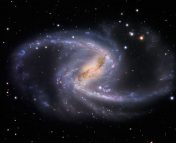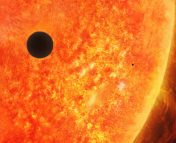Authors: Garett Brown, Hanno Rein
First Author’s Institution: Department of Physics and Environmental Sciences, University of Toronto Scarborough, Toronto, Ontario, Canada
Status: Published in Monthly Notices of the Royal Astronomical Society [closed access]
Last Friday, I went to an Astronomy on Tap event — an informal, outreach-oriented evening of short science talks and astro-trivia — where I heard an interesting claim: planets aren’t real.
The speaker (Ph.D. candidate Taylor Kutra) studies the disks of dust and gas from which planets form. As she noted, the steps involved in that formation are so complicated (and occasionally contradictory) that it sometimes feels like planets just shouldn’t be able to form at all — in a simulated universe with just the basics of formation dynamics, they simply aren’t real.
Of course, she pointed out, planets do form. We’ve observed over 5,300 of them around other stars, and, very importantly, we live on one. So formation works out, and planets are real, but our understanding of exactly why is messy, incomplete, and ever-evolving. This aspect of the talk got me thinking about another stage of a planetary system’s life, filled with similar messiness and apparent unknowability — the end.
Today’s paper makes it clear that understanding planetary systems doesn’t get any easier after formation. For proof, we only need to try to understand the possible futures of our own.
Our murky future
The solar system is chaotic. With so many major bodies at play, there’s no exact solution to the equations of orbital motion. Because of this, despite centuries of theorizing, we don’t know exactly what the future holds for us.
Will the planets stay their course ’til the end of the Sun’s life? Will they fly off the rails in a series of dramatic collisions and ejections? It’s a daunting thought, the unknown… but since the turn of the century, a rise in computing power has let us simulate more possible futures, over longer timescales, with greater precision than ever before.
Of the eight planets, it has been understood since the mid 1990s that Mercury is the most likely culprit for going unstable. In the next 5 billion years (i.e. before the Sun puffs out as a red giant, adding in a whole extra layer of complications), there’s a ~1% chance that the innermost planet’s eccentricity will be pumped up to the point of collision with the Sun or Venus, or that it’ll escape the solar system entirely.
This number was first found from a suite of numerical simulations in 2009, by Jacques Laskar and Mickaël Gastineau. Since then, other researchers have used a range of methods and a variety of situational setups to explore other possible futures. Those who studied the solar system in isolation — ignoring external perturbations from other stars — largely backed up the findings of Laskar & Gastineau: there’s a 1-in-100 chance that things will go unstable over the next 5 billion years.

We are, of course, not in isolation, and if another star passes through the solar system (or even close to it) it would have a huge effect on the orbits of the planets. Luckily, the Sun is in a relatively uncrowded region of the Milky Way — these “stellar flybys” are usually distant, meaning they only have weak effects. When researchers have set up simulations of the solar system in the context of nearby stars, they have found that the flybys strong enough to immediately alter the stability of the solar system are infrequent enough that we can safely assume one won’t happen over the course of the Sun’s life.
But what about a more distant, weaker stellar flyby? While a weak flyby would just barely alter the orbits of the outermost planets, what if this immediate aftermath was just the beginning? In a system that will be around for billions of years, a fractional change today in just one of the planets’ orbits could have a drastic effect on the stability of the rest of the planets down the line. And weaker flybys are orders-of-magnitude more common than stronger ones in all types of stellar environments (Fig. 1).
The authors of this paper put this hypothetical to the test. They aimed to quantify this snowballing effect by studying a key element of orbital dynamics: secular resonances.
Secular Resonances: A Quick primer
In a system like ours with multiple planets, the central star provides the dominant gravitational force and sets most of the parameters of its satellites’ orbits. However, an accumulation of smaller forces — things like general relativity, tidal effects, and, especially, interactions between planets — cause planetary orbits to change over long timescales.
In dynamics, changes that happen over timescales much longer than some time of interest (like the period of an orbit) are called secular changes. In the solar system, the orientation of each planet’s orbit rotates (or “precesses”) with a slow frequency — much slower than its orbital speed. This secular frequency is driven largely by the gravitational pulls of each of the other planets; as a result, each planet’s secular frequency is dependent on the orbital distance of every other planet in the system.
A secular resonance happens when two planets have matching secular frequencies – that is, when the rotation of their orbits synchronizes. When two planets come into a secular resonance, their orbits can change on much faster timescales. Their inclinations and eccentricities shoot up, leading to orbits becoming skewed or crossing each other — a harbinger of instability.
The long-term effects of weak flybys
Perhaps you have a hunch at where this is going. Secular resonances can cause instability, but they only arise when secular frequencies match up. The secular frequency for a planet changes when the orbits of any of the other planets change. Perhaps, then, a small perturbation to one planet’s orbit could shift the frequencies of two other planets into a resonance, which might pump up their eccentricities and destabilize the solar system.
So, by the power of secular dynamics, could flybys make the solar system unstable, if not immediately, then in the long run?
To test this, the authors simulated 2,880 versions of the solar system. In each of them, they simulated a random stellar flyby, with the closeness, mass, and speed of the interloper chosen based on the distribution of stars in our local environment. As the outermost planet, Neptune’s orbit is the most strongly impacted for any given flyby, so they recorded the change in Neptune’s semimajor axis (Δa) to quantify the strength of the perturbation the flyby caused (|Δa/a|). They then tracked whether any planets went unstable in that simulation over the next 4.8 billion years.
In the end, flybys that cause a perturbation of more than 0.1% — one one-thousandth of Neptune’s semimajor axis, or 0.03 AU — led to an increased chance of going unstable compared to models of an isolated solar system. And when the flyby was close enough that Neptune’s orbit changed by ~3 AU, nearly every system went unstable.

While they couldn’t explicitly determine whether secular resonances were driving these instabilities, there was a correlation between the presence of secular resonances during a simulation and eventual instability. Perhaps such resonances could, indeed, be the driver of these delayed instabilities, allowing weak flybys to have big impacts down the line — in short, giving us another thing to worry about when predicting the future.
That all said, in our local environment, flybys close enough to cause perturbations of even 0.1% are still incredibly uncommon. Based on the authors’ calculations, you would expect such a strongly-perturbing flyby only once every 100 billion years — definitely more frequent than flybys that would cause instant instability, but a factor of ten longer than the lifetime of the Sun. Pretty unlikely.
Of course, this isn’t the end of studying solar system instability. Just yesterday, the same authors released a preprint of a new work, looking at the impact of considering general relativity on instability in simulations. There’s always more to consider.
While systems in denser environments should watch out for weak flybys, it seems for now that the solar system won’t be sent spiraling by a nearby star. The beauty of chaos, though, is that it still could. We can predict all we want, but we’ll never know the true fate of these rocks around the Sun until it comes to pass.
Astrobite edited by Kayla Kornoelje
Featured image credit: NASA/JPL




